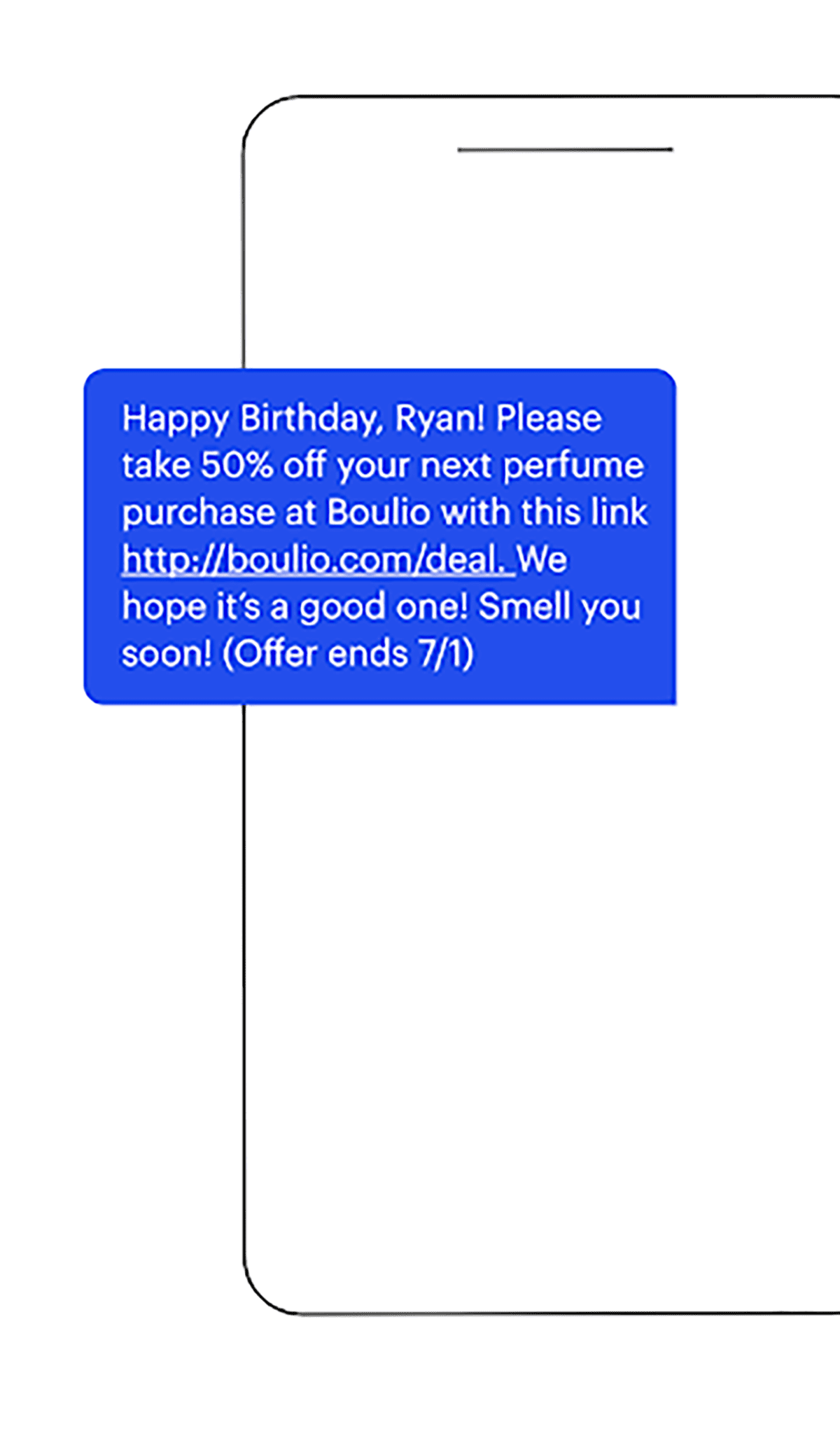What Every Business Needs to Know about SMS Short Code Texting
SMS short code texting may be something your business needs if you have plans to do any text-based marketing campaigns or promotions. If you’re looking into whether you need to set up short code texting, read through this article to learn more and find out important details.
What is an SMS short code?
An SMS short code is a shortened phone number, usually 5 or 6 digits long, that businesses and organizations can use for marketing purposes. You have likely received texts from short code numbers before; this tech is commonly used by organizations such as municipal/utilities, emergency alerts, even pizza places, or for online account verification.
SMS short codes have lots of benefits and some considerations too. Keep reading to learn why businesses may choose to use short code texting.
What are the different types of SMS short codes?
There are a handful of different types of short codes, including:
- Standard (5- or 6-digit): Standard short codes are 5 or 6 digits in length, and are used to send and receive messages.
- Random (8-digit): Unlike standard codes, random 8-digit codes are randomly generated and act similarly to vanity URLs or phone numbers.
- Dedicated (10-digit): Dedicated 10-digit short codes are reserved exclusively for an individual user or company.
Additionally, there are:
- Random Short Codes: A Random short code is randomly generated and works similarly to a vanity URL or phone number.
- Vanity Short Codes: A Vanity short code that can be personalized by the user, typically with a word or phrase. This type of code is used to send and receive messages.
The main difference between random and vanity short codes is that vanity codes can be personalized, while random codes are randomly generated and cannot be customized. Let’s look at a couple of examples.
Examples of Random Short Codes
As we’ve already mentioned, random short cards are exactly that—random. A few examples include:
- 83798828
- 73929421
- 34785968
Examples of Vanity Short Codes
So, what does a vanity short code look like? The following are examples of vanity short codes:
- HELP4U
- URFAVE
- GETSWAG
Why do people use SMS short codes?
The most obvious benefit of using an SMS short code is that your customers don’t have to memorize a 7- or 10-digit phone number (also known as 10DLC which stands for 10-digit long code). A short code is brief and can be customized to be a more memorable vanity number (these are known as vanity short codes), or even correspond to the letters on a phone’s keypad to spell a word.
Having an SMS short code to reference makes it immediately apparent that this text is coming from a business or other organization, and not from a random texter. SMS short codes can also be referenced in an SMS short code directory or short code registry, giving your number more legitimacy.
SMS short codes are memorable, making them also more fitting for keyword marketing. More on that later.
One of the biggest reasons you may consider switching to dedicated short codes is speed. If you have a large opt-in list that you send promotions to over sms and mms messages, you may have noticed that it can take quite a while to text the entire list. That’s because long code numbers can only text about one number per second. If you’re texting a list of 15,000 customers, that means it takes you over four hours just for one campaign. That’s not very conducive to quick results or flash sales.
On the other hand, short code numbers can text close to a hundred messages per second, taking your send time from hours to minutes. The benefit there is clear.

How do I get a dedicated short code?
SMS short code numbers can be leased from the US Short Code Registry. You can search numbers, find memorable combinations, and apply to lease a number right on their website.
Pros and Cons of Using Short Codes for Messaging
Pro: Short codes are easy to remember and type in.
Pro: Short codes can include personalized words or phrases.
Pro: Short codes save time when used regularly.
Pro: Short codes can target a specific audience.
Con: Short codes can be expensive to set up and maintain
Con: Short codes can make the conversation feel less personal.
Con: It can be difficult to track messages sent from short codes.
Advertising your dedicated short code
Part of having a dedicated short code number is letting your customers know about it! If you already have a list, planning and executing a promotion from that number will be a good way to let your existing customers know that’s a convenient communication channel. If you have a SMS short code service or a two-way texting platform like Podium, you can use it to not only send out promotions but answer questions and close deals in the same conversation.
You can also incorporate your dedicated SMS short code into CTAs in advertisements and marketing assets. The more you use it, the more people will know about it.
Compliance for short code texting
In order to use short codes for messaging, companies must make sure they are compliant with all applicable laws and regulations. This includes obtaining proper authorization from relevant agencies, as well as ensuring that any messages sent via short codes comply with industry standards such as opt-in messaging and opt-out options. Companies should also have a clear understanding of their country’s data privacy and spam rules, in order to avoid any potential legal issues.
SMS Short Codes & Business Phone Numbers – What is the Difference?
With a business phone number, you can call and text your customers from a local and trusted area code with a 10-digit long code number. With Podium, it’s easy to get set up with a textable business line so you can do things like send review invites, make appointments, answer questions, run text campaigns, and get paid over text. Check out Podium Starter to get some of the best texting tools for local businesses, and get started for free.

With a short code number, you can still text, send promos, and do everything else over text. Your number doesn’t show up with a local area code, which can be both a pro and a con—it legitimizes your text as being from a business but it may seem unfamiliar at first glance.
Short Codes as part of your SMS marketing strategy
Any local business should have texting as part of their marketing strategy. If you want to begin an SMS marketing strategy, you can do so with either a short code or long code number.
SMS marketing is convenient, easy, and gets great results. Over 98% of texts get opened, and almost all of them within a few minutes. Email and other direct contact marketing channels get much poorer open rates and click through rates.
There’s a big level of trust involved with texting, however, and if you use your short code SMS number to spam your customers, you could see high unsubscribe rates and your number could even be blocked permanently by telecom service providers. Make sure you don’t run afoul of text marketing laws that are designed to protect consumers.
Best practices for SMS marketing
When you’re using text as a marketing channel, as stated above, there are some things you can do to get great results, and there are also some things you should absolutely not do. Text is powerful because it’s such an intimate form of communication, which means if you abuse that trust, your customers could be upset and you could even find yourself in legal trouble. Here are some tips and tricks on how to get the most out of business messaging and SMS marketing in particular:
- Don’t spam. That means a couple different things: first of all, don’t send multiple messages a day. That will get annoying really quickly. At most you should probably aim for a couple promotional texts per week so you don’t lose that efficacy. And secondly, you want to make sure each message provides value to the consumer. Don’t text just to text; have a strategy and a campaign in mind. Send promotions and deals that will be useful to your customers.
- Be friendly. Text like a person! Your customers are much more likely to respond to a message that addresses them by name and has familiar language, something like, “Hi Tom, this is Sandra from Dynasty Jewelry. We’re having a pre-Black Friday sale this weekend! Follow this link to learn more: [url]” Your customers will have a much better response to that sort of personal language than something like this: “DEALS DEALS DEALS! Catch our Fall Sale NOW! [url]”
- Be creative. Don’t just send the same template every other week. Make it relevant to your customer. Seasonal sales and promotions are a good way to provide value, whether it’s for holiday shopping, back to school, or just as a way to keep the messaging fresh. Some businesses also send deals to customers for their birthday or significant life events like anniversaries.
FAQs
How To Sign Up For Short Code Texts
Signing up for short code texts is pretty straightforward. First, you need to check with your network operator if they support short code messaging. Once you’ve confirmed this, you will need to obtain a short code from the relevant carrier or service provider. You can usually do this online, but some operators may require you to register in person. Once you have obtained your short code, you will be able to begin sending messages using that particular code.
How To Unsubscribe From Short Code Messages
Unsubscribing from short code messages is easy as long as a business is following compliance laws properly. Generally, most providers will give you the option to reply ‘STOP’ when a short code message is sent to you. Alternatively, users can contact their operator’s customer services department and request to unsubscribe from short code messaging.
How can I find out who owns a short code?
To find out who owns a particular short code, you’ll need to contact your network provider and ask them if they offer the corresponding service. They may or may not be able to provide you with the name and contact details of the short code owner.
Another option is to use an online search engine such as Google or Yahoo and type in the specific short code that you are looking for.
Summary and Conclusion
Text marketing is a powerful tool. With an SMS short code or long code number, you should be prepared to use text messages in your marketing strategy.
















